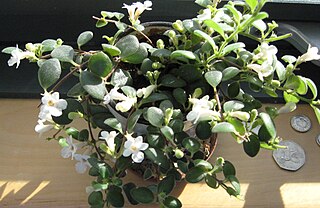Plasmodium kentropyxi is a parasite of the genus Plasmodium subgenus Sauramoeba.

Troschel's treefrog, also known as the blue-flanked treefrog or the convict treefrog, is a species of frog in the family Hylidae. It is found in most parts of the Amazon Basin including Suriname. Colombian, Guianan and Venezuelan records need confirmation.

The Colombian horned frog or Venezuelan horned frog is a species of frog in the family Ceratophryidae. It is found in Colombia and Venezuela. Its natural habitats are dry savanna, subtropical or tropical dry shrubland, subtropical or tropical dry lowland grassland, and intermittent freshwater marshes.
Scaphiophryne calcarata, Moquard's Burrowing Frog, is a species of frog in the family Microhylidae. It is endemic to Madagascar. Its natural habitats are subtropical or tropical dry forests, dry savanna, moist savanna, subtropical or tropical dry shrubland, subtropical or tropical dry lowland grassland, intermittent freshwater marshes, arable land, and urban areas. The species is adaptable and is not affected by deforestation.
Rollinia calcarata is a species of plant in the Annonaceae family. It is endemic to Brazil.

Codonanthe is a genus of mainly epiphytic plants in the family Gesneriaceae, endemic to the Atlantic Forest of Brazil. The botanical name comes from the Ancient Greek for 'bellflower'. They have white or pale pink flowers and somewhat fleshy leaves. In 2013, the genus was reduced in size when more than half of the species were transferred to Codonanthopsis. They can be grown as houseplants, particularly in hanging baskets. Artificial crosses with Nematanthus hybrids have produced the hybrid genus × Codonatanthus.

Eltroplectris, the long-claw orchid, is a genus of flowering plants from the orchid family, Orchidaceae. It is native to South America, the West Indies, and Florida.
- Eltroplectris assumpcaoanaCampacci & Kautsky - Brazil
- Eltroplectris brachycentronSzlach. -Bolivia
- Eltroplectris calcarata(Sw.) Garay & H.R.Sweet - Florida, Bahamas, Cayman Islands, Cuba, Hispaniola, Jamaica, Puerto Rico, Windward Islands, Trinidad, Suriname, Venezuela, Colombia, Peru, Brazil, Paraguay
- Eltroplectris cogniauxiana(Schltr.) Pabst - Brazil
- Eltroplectris dalessandroiDodson - Ecuador
- Eltroplectris janeirensis(Porto & Brade) Pabst - Brazil
- Eltroplectris kuhlmanniana(Hoehne) Szlach. & Rutk. in P.Rutkowski, D.L.Szlachetko & M.Górniak - Brazil
- Eltroplectris longicornu(Cogn.) Pabst - Brazil
- Eltroplectris macrophylla(Schltr.) Pabst - Brazil
- Eltroplectris misera(Kraenzl.) Szlach. - Brazil
- Eltroplectris rossiiDodson & G.A.Romero - Ecuador
- Eltroplectris schlechteriana(Porto & Brade) Pabst - Brazil, Argentina, Paraguay
- Eltroplectris triloba(Lindl.) Pabst - Brazil, Argentina, Paraguay

Sveltia is a genus in the subfamily Cancellariinae of the nutmeg sea snails with an extensive fossil range.

Kentropyx calcarata, commonly known as the striped forest whiptail, is a species of lizard endemic to South America.

Eurycantha calcarata is a species of phasmid endemic to Australasia.

Eltroplectris calcarata, the longclaw orchid, is a terrestrial species of orchid. It is native to Florida, Bahamas, Cayman Islands, Cuba, Hispaniola, Jamaica, Puerto Rico, Windward Islands, Trinidad, Suriname, Venezuela, Colombia, Peru, Brazil, and Paraguay.
Codonanthopsis elegans is a plant species in the family Gesneriaceae. It is endemic to Belize.

Ceratina calcarata, the spurred ceratina, is a species of small carpenter bee in the family Apidae. It is found in eastern North America. This species ranges from Georgia, USA north to Ontario, Canada and east to Nova Scotia, Canada. This bee is a common generalist, native pollinator, it pollinates plants like watermelon and cucumber very effectively. C. calcarata adds to the productivity of a wide range of ecological and agricultural systems due to its wide range and abundance. This small bee is becoming a model organism in the scientific research of social evolution. C. calcarata is the first subsocial bee species to have its genome published, allowing researchers to investigate the evolutionary origins of social behaviour.

The Gesnerioideae are a subfamily of plants in the family Gesneriaceae: based on the type genus Gesneria. Although genera typically originate in the New World, some species have become widely distributed as ornamental plants.

An ant garden is a mutualistic interaction between certain species of arboreal ants and various epiphytic plants. It is a structure made in the tree canopy by the ants that is filled with debris and other organic matter in which epiphytes grow. The ants benefit from this arrangement by having a stable framework on which to build their nest while the plants benefit by obtaining nutrients from the soil and from the moisture retained there.

Vanhouttea is a genus of flowering plants in the African violet family Gesneriaceae, native to south-eastern Brazil. They are pollinated by hummingbirds.

Codonanthopsis is a genus of flowering plants in the family Gesneriaceae. Its native range is from southern Mexico through tropical America to Bolivia and most of Brazil. Codonanthopsis species are generally trailing epiphytes with pale flowers. Most have a mutualistic relationship with tree-living ants: the plants provide the ants with food, including nectar, and give their nests structure and support, while the ants disperse the plants' seeds. The genus was considerably expanded in 2013 when species were transferred from Codonanthe. Some Codonanthopsis species are cultivated as houseplants, when they may be grown in hanging baskets.
Codonanthopsis dissimulata is a species of flowering plant in the family Gesneriaceae. This species is native to northern Brazil, Colombia, Ecuador, French Guiana, Guyana, Peru, and Venezuela. Is an epiphyte and mainly grows in wet tropical biomes. The description was first published in 1978.

Codonanthopsis uleana is a species of flowering plant in the family Gesneriaceae. This species is native to Mexico and America. Is an epiphyte and mainly grows in wet tropical biomes.
Codonanthopsis ulei is a species of flowering plant in the family Gesneriaceae. This species is native to tropical South America, ranging from Colombia and southern Venezuela to northern Brazil, Ecuador, and Peru. It is an epiphyte and mainly grows in wet tropical biomes.













